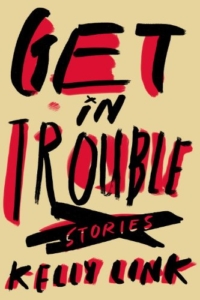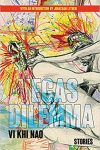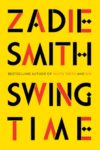New Wave Fabulism — coined by Conjunctions in the early aughts — is a small post-postmodern movement that, at least according to the litmag, included Kelly Link, Aimee Bender, Peter Straub, and Jonathan Lethem. Around the same time, China Miéville’s term “New Weird” also became a thing, and could likewise be applied to these authors, especially taken at face value for being “new” and “weird.” (Kelly Link has, herself, said that because people will inevitably taxonomize literature to better grasp it, she prefers Miéville’s alternate description: “Weird Shit.”) Since, the genre-fuck of these early-2000s works seems to have inseminated a whole new — and much larger — generation of American short fiction authors’ output. The coexistence of the banal and the poetically strange has become a new norm to the extent that the strangest thing that could happen in a story of modern, domestic malaise is for a struggling single mother not to, say, turn into a doily.
Because of what seems like an upsurge in authorial supply and reader demand for weirdness (of which, as a reader, I wholeheartedly play a part), book jacket synopses for collections of short fiction now appear as part of an at-times exhausting game of aberrance one-upmanship. If it can’t be described in a slipstream-of-consciousness PR poem to the tune of “This singular collection envisions alternate presents where the elderly are referred to as Fertilizer, where ramps are both a coveted onion and the President but not a manmade slope, and where immigration reform is being slowed by taffy,” it hardly seems worth reading. To skeptics, the anti-genre that Link helped pioneer with her 2001 collection Stranger Things Happen can be a gateway toward sidestepping subtextual acuteness and researched realism — of externalizing emotional detail to avoid a deeper understanding of it while substituting more studied environmental realness for less accuracy-reliant whimsy.
Link’s new collection, Get in Trouble — which comes 10 years after her last release — is her first book since the trend she helped create became such a visible, and even expected, manner of short storytelling. (As another indication of the mainstreaming of New Wave Fabulism — or whatever you want to call it — this is Link’s first book published by Random House, as opposed to her own Small Beer Press.) So before Getting in Trouble, I wondered whether the successes of works by authors such as Karen Russell, Kelly Luce, Ramona Ausubel, and Shane Jones would change my relationship to the Link-reading experience: if no longer astonished by what seemed like the radicalism of her genre confluence, how would I respond to the rest of it? Quite ecstatically, it turns out.
In Get in Trouble, Link vacillates between using the fantastical as an apt decentering backdrop (the butter villains of “Secret Identity,” the disappeared nudist colony of “I Can See Right Through You”) and a fundamental, thematically central force in the stories (the mysterious, gilded-bauble fabricating Summer People in “The Summer People,” the assorted genre-fiction Boyfriend dolls in “The New Boyfriend”). As mentioned, readers have come to expect the unexpected, yet Link somehow goes places even our weirdness foresight can’t reach.
Perhaps the best example of this is “Secret Identity,” in which a teenage catfish (despite the collections’ fabulist bent, I’m not referring to a parahuman, but rather to the MTV definition of “catfish”) comes to a hotel in New York to finally meet the established quadragenarian man she’s been virtually flirting with. The hotel, we find out, is hosting a convention for superheroes. They’re simultaneously hosting a convention for dentists. Instead of meeting up with the object of her nascent desires, as a more linear story might have it, she wanders through the conventions of tooth saviors and general humanity saviors (rendered mundane by their proximity to the unglamorousness of dentistry) and befriends a wealthy hedonist who lives in the hotel; she ultimately follows him into a walk-in freezer full of effigies of supervillains, all sculpted in butter.
The superhero theme — which is also on display more centrally in “Origin Story” — here speaks to the achingly lonely middle spaces occupied by teenagers (this is one of the more overarching themes of the collection). Like the geekiest of superheroes, Billie has established a double-identity by posing as her much older sister on an online RPG. The funny thing is that the RPG gives her more exhilaration than the actual presence of superheroes, who rather, with their uniform clad identities and self-summarizing titles, make her seem nebulous and quintessentially teenage in her inability to define herself. It’s a magnification of how groundless a teenager feels when presented with any group of adults with professional nametags; “I’m a ________” are some pretty unknowable words to a teen:
“You, girl,” the superhero says. “Are you here with Miracle?”
Billie realizes a mistake has been made. “I’m not a sidekick,” she says.
“Then who are you?” the superhero says.
“Nobody,” Billie says. And then, because she remembers that there’s a superhero named Nobody, she says, “I mean, I’m not anybody.” She escapes before the superhero can say anything else.
But just as it might seem the superheroes could serve too much of a symbolically direct function, we get the butter villains scene. While eerie and even violating insomuch as Billie is in a freezer with a strange and mildly sociopathic man who throws a butter head at her, it also just seems like a somewhat self-contained scene about a freezer full of butter villains — and why should the butter villains, here, be anything more? In Link’s stories, the fantastic has its place in the center and in the margins, in the symbolic and in the decorative.
Link shows her awareness of the more romantic qualities of mainstream fantasy, then de-romanticizes it to hilarious effect: it makes sense, as Meg Wolitzer has noted, that the stories that banalize or twist our notions of fantastical heartthrobs are about teens. Link’s fantasy works so well because she’s also acutely aware of real-world detail: the teenage protagonist in “The New Boyfriend” consumes frozen yogurt, oreos, and GIFs of celebrity penises while with her friends and waxes profound — dreaming of curving roads and oceans and pondering solipsism — while alone. “The New Boyfriend” is actually about a series of “Boyfriends,” all of which are just highly advanced life-sized dolls modeled after vampires, werewolves, and ghosts that a caring and moneyed parent might purchase for their daughters. In this story, teens are quite literally being sold the romance of the fantastical. In the case of the Ghost Boyfriend, it is not the conventional idea of the echo of the dead trying to reach the living that makes it so unsettling, but rather the notion that that winningly typical eeriness, itself, is simulated by a commodity — that that thing that haunts and woos a teenager is actually the echo of some corporation capitalizing on adolescent longing, sexuality, and emptiness. It’s put in perspective with this side detail suggesting the simulacral fulfillment of another form of biological and emotional desire:
Over in the corner of the yogurt shop a middle-aged woman sits and moves a stroller back and forth with one hand while she eats with the other. Immy keeps looking over. She can’t tell if it’s a real baby in the stroller or a Baby.
But Link’s impeccable ability to overturn our expectations is only potent because of the excellence of her prose and her adeptness at wholly exposing the gorgeous and upsetting topographies of her characters’ emotional lives. The fantasy may waver in its functions, but one thing it never does is distract from this. It’s never a decoy. Her fundamental gifts as a storyteller are apparent in “The Lesson,” the most gripping and unadorned piece in the collection. Here, a gay couple attends the bizarre wedding of an old friend on an island with no cell phone reception while, far off on the mainland, their surrogate is having issues with her pregnancy. The protagonist Thahn’s experiences are overlaid with stream-of-consciousness details about premature infants.
Lunch has been delivered on the boat. Thanh doesn’t want any lunch. In a male baby born at twenty-four weeks, the scrotum and glans of the penis have not yet developed. The skin cannot hold heat or moisture in. They have no fat, no reserves. They are stuck with needles, tubes, wires, monitors. Astronauts in the smallest diapers you have ever seen.
In a literary world where strangeness waxes normative, Link continues to assert that she’s not a mere master of New Wave Fabulism, whatever that is or was. She writes characters whose stagnated lives can’t be saved by escapist fantasy — because fantasy is right there, stagnating, however strikingly, right next to them. There’s nowhere, really, to be swept away to: in the last story, “Light,” the “pocket [alternate] universes” have been opened up, and are overrun with tourists — a seeming nod to the new proliferation of the weird. It’s not entirely bleak, though — in some stories, there’s a glimmer of the notion that while the world(s) may seem a stretching plateau, occasionally one can encounter someone whose experience of it seems mutual enough to traverse it together — though there’s no guarantee that someone will be human, or necessarily even sentient, or necessarily even tangible.
Moze Halperin is an almost-Brooklyn almost-playwright and almost-author. He likes ham (from time to time).
This post may contain affiliate links.








